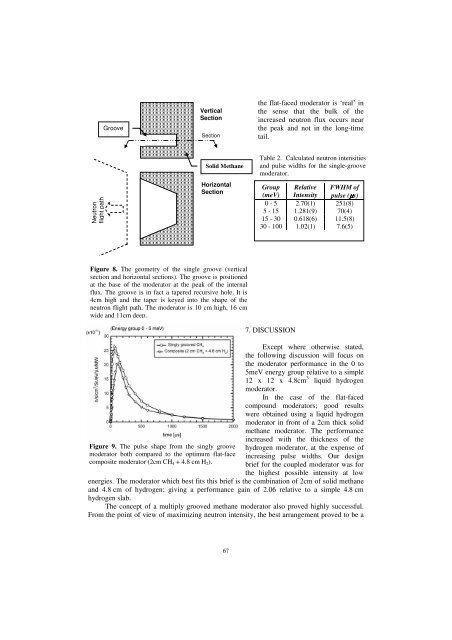Druck-Materie 20b.qxd - JUWEL - Forschungszentrum Jülich
Druck-Materie 20b.qxd - JUWEL - Forschungszentrum Jülich
Druck-Materie 20b.qxd - JUWEL - Forschungszentrum Jülich
You also want an ePaper? Increase the reach of your titles
YUMPU automatically turns print PDFs into web optimized ePapers that Google loves.
Neutron<br />
flight path<br />
Groove<br />
Vertical<br />
Section<br />
Section<br />
Solid Methane<br />
Horizontal<br />
Section<br />
Figure 8. The geometry of the single groove (vertical<br />
section and horizontal sections). The groove is positioned<br />
at the base of the moderator at the peak of the internal<br />
flux. The groove is in fact a tapered recursive hole. It is<br />
4cm high and the taper is keyed into the shape of the<br />
neutron flight path. The moderator is 10 cm high, 16 cm<br />
wide and 11cm deep.<br />
Figure 9. The pulse shape from the singly groove<br />
moderator both compared to the optimum flat-face<br />
composite moderator (2cm CH4 + 4.8 cm H2).<br />
67<br />
the flat-faced moderator is ‘real’ in<br />
the sense that the bulk of the<br />
increased neutron flux occurs near<br />
the peak and not in the long-time<br />
tail.<br />
Table 2. Calculated neutron intensities<br />
and pulse widths for the single-groove<br />
moderator.<br />
Group Relative FWHM of<br />
(meV) Intensity pulse (µµµµs)<br />
0 - 5 2.70(1) 251(8)<br />
5 - 15 1.281(9) 70(4)<br />
15 - 30 0.618(6) 11.5(8)<br />
30 - 100 1.02(1) 7.6(5)<br />
7. DISCUSSION<br />
Except where otherwise stated,<br />
the following discussion will focus on<br />
the moderator performance in the 0 to<br />
5meV energy group relative to a simple<br />
12 x 12 x 4.8cm 3 liquid hydrogen<br />
moderator.<br />
In the case of the flat-faced<br />
compound moderators; good results<br />
were obtained using a liquid hydrogen<br />
moderator in front of a 2cm thick solid<br />
methane moderator. The performance<br />
increased with the thickness of the<br />
hydrogen moderator, at the expense of<br />
increasing pulse widths. Our design<br />
brief for the coupled moderator was for<br />
the highest possible intensity at low<br />
energies. The moderator which best fits this brief is the combination of 2cm of solid methane<br />
and 4.8 cm of hydrogen; giving a performance gain of 2.06 relative to a simple 4.8 cm<br />
hydrogen slab.<br />
The concept of a multiply grooved methane moderator also proved highly successful.<br />
From the point of view of maximizing neutron intensity, the best arrangement proved to be a

















